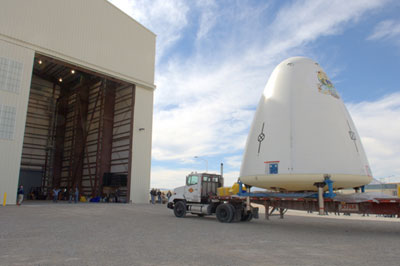Please, Mr. Bezosby Taylor Dinerman
|
| A suborbital vehicle that will be able to take tourists up to the edge of space and compete with Scaled Composites’ SpaceShipTwo will be a welcome addition to the suborbital market: may the best rocket win. But why all the secrecy if that is all there is to it? |
In order to make risky but informed investment decisions, both the private sector and governments need to have some idea of what future costs for access to space are going to look like. If the costs remain at today’s high levels, where they have basically be stuck since the late 1990s, then the development of the off-world economy is going to be done at a snail’s pace. If, however, the costs do in fact drop dramatically, or even if there is a realistic prospect of such a drop, then things will look very different.
So far, all we really know about Blue Origin’s reusable launch vehicle (RLV) project, is that the flew a test vehicle to an altitude of less than 100 meters in November 2006. That test item, called “Goddard”, is a precursor to a suborbital vehicle called the New Shepard that may fly sometime around 2010. Beyond this, we know from their web site that they want to hire people “with turbopump or propulsion experience on large, modern, cryogenic engines such as the RS-68.”
That leaves us with lots of room to speculate about what they are up to. The shape of the Goddard vehicle reminds many old space hands of the original Max Hunter SSX design from the late 1980s. He laid out some of the details in his classic paper “SSX – Design for Flight Safety” which paved the way for the engineering philosophy behind the DC-X Delta Clipper. It would seem, at least to outsiders, that Bezos and his team are following Hunter’s “build a little, test a little” idea.
A suborbital vehicle that will be able to take tourists up to the edge of space and compete with Scaled Composites’ SpaceShipTwo will be a welcome addition to the suborbital market: may the best rocket win. But why all the secrecy if that is all there is to it? Why build a craft that can almost reach orbit unless, eventually, one wants to go all the way? So are we going to see a New Shepard 2? Will it be single stage to orbit (SSTO) or will it need two stages? Will it use plug aerospike engines or something more conventional?
More important, will Blue Origin be the first one to build a reliable, cost-effective RLV? If the money is there, and since they do not have to deal with the usual overhead caused by the mass of government regulations that a NASA or DoD contractor has to deal with, they may accomplish the goal sooner than anyone expects, say around 2012 or 2013. That’s before the Ares 1 rocket and its Orion capsule become operational.
The team that Bezos has built has no obligation to provide the public with any information on its plans other than what it has to give to the FAA’s Office of Commercial Space Transportation in order to get a license to operate. Thanks to Jeff Bezos’ money they do not have to seduce investors or satisfy politicians or bureaucrats. They can just get on with the job with no distractions or pressure. In many ways it’s an ideal situation.
Yet for the space industry, and in the long term for Blue Origin itself, it might be wise for them to be a bit more forthcoming about their long-term plans. The aerospace industry in general and the RLV industry in particular has a well-developed informal feedback loop that allows for a certain degree of informed debate that sometimes shows itself to be of real value. By staying aloof from this community, the designers and builders of the New Shepard may be cutting themselves off from some useful ideas. There are limits on what any company wants to share with outsiders, but, taken to an extreme, secrecy is not a healthy thing.
| By staying aloof from the space community, the designers and builders of the New Shepard may be cutting themselves off from some useful ideas. There are limits on what any company wants to share with outsiders, but, taken to an extreme, secrecy is not a healthy thing. |
Except for a few direct competitors, everyone in the space industry should be hoping and praying for the success of Blue Origin. The company seems to have adequate capital, a solid design, and a realistic business plan, but that judgment is based on nothing but conjuncture and guesswork. If they do succeed in dramatically reducing the cost per pound to orbit five or six years from now, the implications for the space economy and for the world’s economy are huge.
So please, a little more openness. It can’t hurt, and it might even help.
